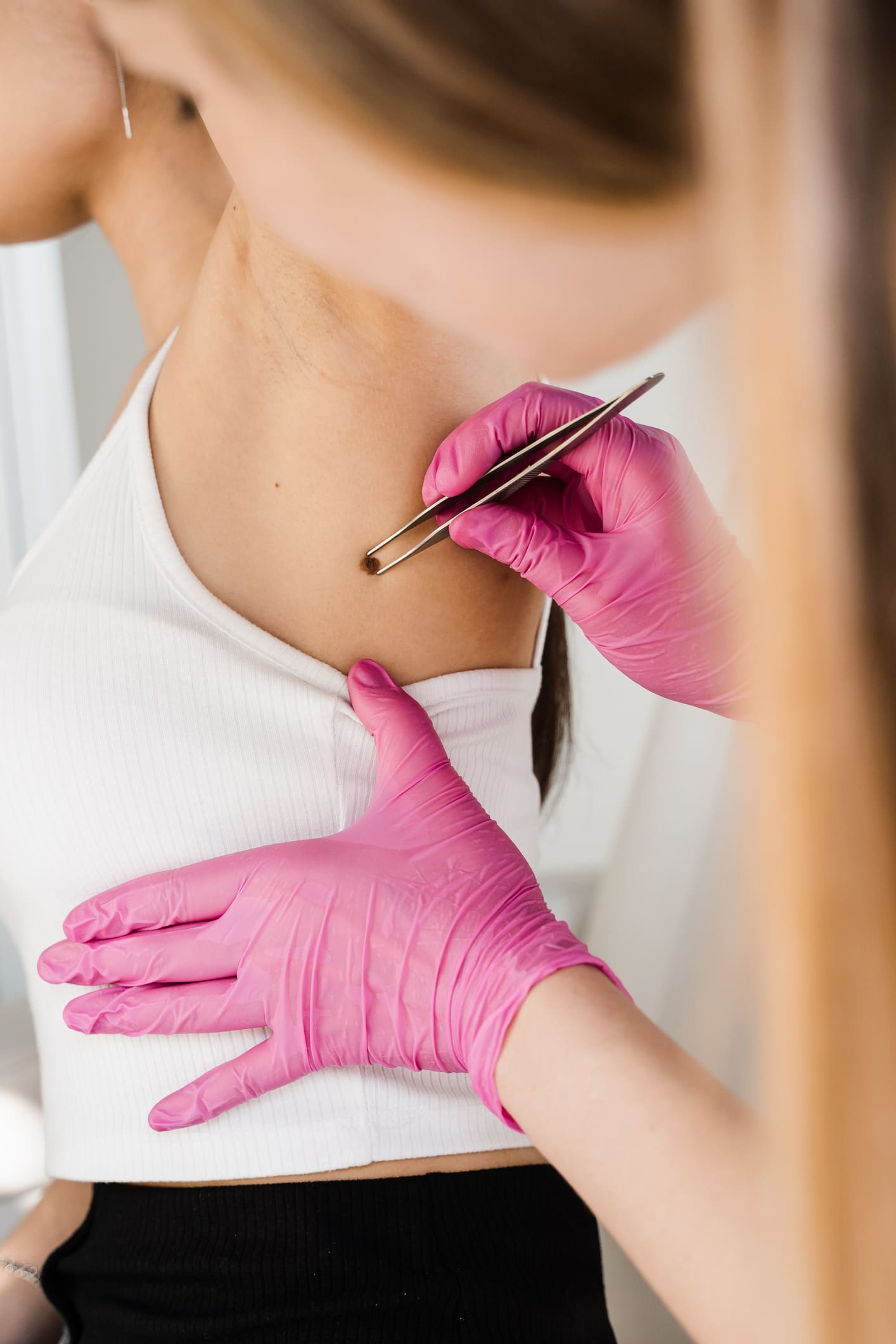Skin Cancer Treatment
in Phoenix, Arizona
At Arizona Skin, we are dedicated to providing advanced and effective skin cancer treatments to our patients in Phoenix, Scottsdale, Buckeye, Surprise, and beyond. Understanding the various treatment options available for skin cancer is crucial for our patients. Our practice offers a range of state-of-the-art treatments, tailored to meet the unique needs of each individual. Below, we’ll explore some of the key techniques that Dr. Mehta uses in treating skin cancer.
What is Skin Cancer Treatment?
Skin cancer treatment is actually a family of procedures used to treat skin cancer, ranging from surface treatments and minimally-invasive approaches to surgical intervention. There are different risks and benefits of each procedure, and the best solution will be selected based on the type, location, and stage of your skin cancer. Leading dermatologist Dr. Jay Mehta offers a variety of skin cancer treatments and uses them to treat a variety of skin cancer types, including:
- Actinic keratoses (AKs)
- Basal cell carcinoma (BCC)
- Squamous cell carcinoma (SCC)
- Melanoma
- Merkel cell carcinoma

How is Skin Cancer Treated?
Arizona Skin specializes in a range of skin cancer treatment options to offer patients the best treatment experience and highest efficacy rates. We offer skin cancer treatment with the following techniques:
Photodynamic Therapy (PDT)
Photodynamic therapy is a non-invasive treatment that combines a photosensitizing agent with a specific type of light to destroy skin cancer cells. It’s mainly used for superficial skin cancers and pre-cancerous growths, offering the benefits of minimal invasiveness, precise targeting of cancer cells, the ability to repeat the treatment if necessary, and typically leaving little to no scarring.
Cryosurgery
Cryosurgery is an effective method for treating small and superficial skin cancers, where liquid nitrogen is applied to the cancer cells, causing them to freeze and die. This technique is valued for its simplicity, not requiring anesthesia, and results in minimal bleeding and pain, quick recovery, and minimal scarring.
Electrodesiccation and Curettage (ED&C)
Electrodesiccation and curettage involves scraping away cancer cells with a curette and then using electricity to destroy any remaining cells. This approach is commonly used for small, superficial basal and squamous cell carcinomas, known for being a quick procedure, effective for certain types of cancers, and typically only requiring local anesthesia.
Excision
Excision involves surgically removing the cancerous tissue along with a margin of healthy skin. It is a widely used technique for treating both melanoma and non-melanoma skin cancers. The procedure, which often only requires local anesthesia, allows for the histological examination of the tumor and has a high cure rate for many types of skin cancers.
Intralesional Chemotherapy
Intralesional chemotherapy is a treatment where chemotherapy drugs are injected directly into the tumor, primarily used for advanced or challenging skin cancers. This localized approach focuses on the tumor without affecting the rest of the body, can be combined with other treatments, and typically requires multiple sessions, with potential side effects localized to the treatment area.
What is the Best Skin Cancer Treatment for Me?
Determining the “best” skin cancer treatment is highly individualized and depends on a variety of factors specific to each patient. There is no one-size-fits-all answer, as the most effective treatment plan varies based on several critical aspects, including:
- Type of Skin Cancer: Different types of skin cancer (such as basal cell carcinoma, squamous cell carcinoma, melanoma, etc.) respond differently to various treatments. The nature and aggressiveness of the cancer type play a crucial role in determining the treatment approach.
- Stage and Severity: Early-stage skin cancers may require less invasive treatments compared to advanced or aggressive cancers. The size, depth, and extent of the cancer significantly influence the choice of treatment.
- Location of Cancer: Skin cancers on certain parts of the body, like the face, might need treatments that consider cosmetic outcomes. Similarly, cancers in hard-to-treat areas may require specialized approaches.
- Patient’s Health and Medical History: Overall health, age, and medical history, including previous skin cancer treatments, can impact treatment choices. Certain methods may not be suitable for individuals with specific health conditions.
- Patient’s Preferences and Lifestyle: Personal preferences, lifestyle considerations, and the patient’s ability to follow through with the treatment regimen are important. Some treatments may require multiple sessions or have varying recovery times that might not align with every patient’s lifestyle or preferences.
- Potential Risks and Side Effects: Each treatment comes with its own set of potential side effects and risks. Balancing the effectiveness of treatment with these considerations is crucial.
Given these diverse factors, the best approach is to have a detailed discussion with a specialized dermatologist, like Dr. Jay Mehta of Arizona Skin. Dr. Mehta can provide a thorough evaluation and tailor a treatment plan that aligns with your specific type of skin cancer, overall health, and personal preferences.
How Effective is Skin Cancer Treatment?
The effectiveness of skin cancer treatment varies depending on several factors including the type and stage of cancer, the patient’s overall health, and how early the cancer is detected. Generally, treatments for skin cancers like basal cell carcinoma and squamous cell carcinoma are highly effective, especially when detected early. Melanoma can also be effectively treated if caught in its early stages. The efficacy diminishes as the cancer advances or metastasizes. Each case is unique, and the success rate of treatment is best discussed with Dr. Mehta.
How Much Does Skin Cancer Treatment Cost?
The cost of skin cancer treatment can vary depending on the type of treatment, and the severity and location of the cancer. Additionally, as most health insurance plans offer coverage for skin cancer treatment, the out-of-pocket treatment costs will vary further depending on the extent of coverage provided. Patients are encouraged to check their health insurance plans to determine their eligibility for coverage. Furthermore, Arizona Skin offers financing options to make all our treatments more affordable.
If you are in Phoenix, Scottsdale, Buckeye, Surprise, or the surrounding areas of Arizona, contact us today to schedule your consultation for skin cancer treatment at Arizona Skin. During your consultation with Dr. Mehta, you can discuss the most appropriate treatment options based on your skin type and skin cancer diagnosis.
If you are experiencing any skin concerns or conditions, don’t hesitate to reach out to Arizona Skin. Our team of experts is here to provide you with the highest quality medical dermatology care in the Greater Phoenix area. Contact us today to schedule your appointment and take the first step towards healthier skin. We welcome patients from Scottsdale, Surprise, and Buckeye, Arizona.
